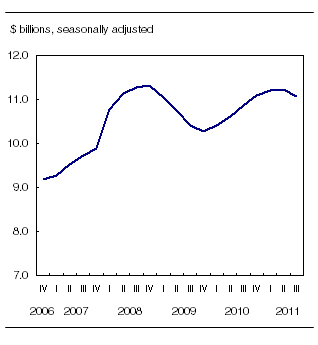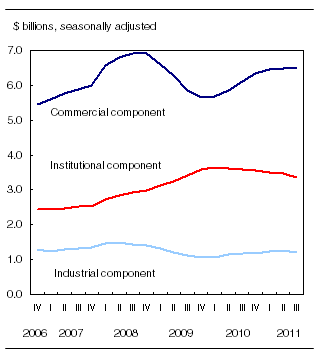Investment in non-residential building construction
Archived Content
Information identified as archived is provided for reference, research or recordkeeping purposes. It is not subject to the Government of Canada Web Standards and has not been altered or updated since it was archived. Please "contact us" to request a format other than those available.
Related subjects
-
[an error occurred while processing this directive]
Investment in non-residential building construction decreased 1.3% to $11.1 billion in the third quarter, following six consecutive quarters of growth. This decline was largely driven by a continuing downward trend in investment in institutional building construction.
Investment in non-residential building construction

Chart description: Investment in non-residential building construction
Among the seven provinces that posted declines in the third quarter, Alberta and Ontario recorded the largest decreases. In Alberta, the largest part of the decline came from lower institutional investment, while in Ontario it was mostly a result of lower commercial investment. Both provinces recorded smaller declines in industrial construction.
The largest increases occurred in British Columbia and Newfoundland and Labrador, led by higher industrial investment in both provinces.
Investment was down in 17 of the 34 census metropolitan areas. The largest declines occurred in Edmonton, Kitchener and Barrie. All three components fell in Edmonton, led by institutional investment. Commercial investment was down in Kitchener, while institutional investment declined in Barrie.
Note to readers
Unless otherwise stated, this release presents seasonally adjusted data expressed in current dollars, which facilitates comparisons by removing the effects of seasonal variations.
Investments in non-residential building construction exclude engineering construction. This series is based on the Building Permits Survey of municipalities, which collects information on construction intentions.
Work put-in-place patterns are assigned to each type of structure (industrial, commercial and institutional). These work patterns are used to distribute the value of building permits according to project length. Work put-in-place patterns differ according to the value of the construction project; a project worth several million dollars will usually take longer to complete than will a project of a few hundred thousand dollars.
Additional data from the Capital and Repair Expenditures Survey are used to create this investment series. Investments in non-residential building data are benchmarked to Statistics Canada's System of National Accounts of non-residential building investment series.
For the purpose of this release, the census metropolitan area of Ottawa–Gatineau (Ontario/Quebec) is divided into two areas: the Ottawa part and the Gatineau part.
The largest gains occurred in Montréal, Calgary and London. The increases in Montréal and Calgary were a result of higher commercial investment, while the advance in London came from institutional investment.
Institutional component
Spending in the institutional component totalled $3.4 billion in the third quarter, down 3.5% from the second quarter and the sixth consecutive quarterly decline.
Institutional investment fell in seven provinces. The largest declines were in Alberta, where spending fell 20.0% to $398 million, and in Quebec where it was down 7.0% to $519 million. Both provinces saw lower spending in several institutional categories.
The largest increase was in Ontario, and resulted from higher investment in government buildings and health care facilities.
Commercial, institutional and industrial components

Chart description: Commercial, institutional and industrial components
Commercial component
Investment in commercial building construction edged up 0.4% to $6.5 billion, the seventh consecutive quarterly gain. However, the rate of growth of commercial investment has been slowing since the first quarter of this year. The main factor for the third quarter increase was higher spending on construction of office buildings and retail and wholesale outlets.
Commercial investment increased in four provinces in the third quarter. The largest increase occurred in Alberta, where investment rose 6.2% to $1.5 billion. This was the sixth consecutive quarterly gain. In Quebec, investment increased 3.8% to $1.1 billion.
Alberta's gains came mostly from office buildings, transportation facilities and warehouses. Advances in Quebec were mostly in research centres and retail and wholesale outlets.
Industrial component
Investment in industrial projects totalled $1.2 billion in the third quarter, down 4.3% from the previous quarter. This was the first decline after five consecutive quarterly gains.
Provincially, Alberta and Ontario contributed the most to the decline in the industrial component. In both provinces, the decrease came mainly from lower investment in utility buildings.
British Columbia had the largest increase, as a result of higher spending on maintenance buildings.
Available on CANSIM: table 026-0016.
Definitions, data sources and methods: survey number 5014.
More detailed data on investment in non-residential building construction are also available in free tables online. From the Key resource module of our website choose Summary tables.
For more information, or to enquire about the concepts, methods or data quality of this release, Don Overton (613-951-1239; bdp_information@statcan.gc.ca), Investment and Capital Stock.
- Date modified:
